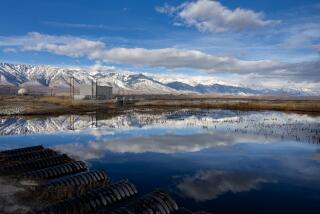Less water might be plenty for California, experts say, and conservation is only the start

- Share via
Across California this summer, residents have been racking up water conservation numbers that defy expectations — a 27% reduction in June, followed by 31.3% in July.
Perhaps more impressive than the percentage figures, however, is the actual volume of water saved over two months: 414,800 acre-feet.
That’s a lot of water — more than twice the amount projected to be available annually from two proposed storage facilities that would cost a combined $3.5 billion to build: the Temperance Flat Dam on the San Joaquin River and an expansion of Shasta Dam.
The conservation performance raises a host of possibilities, and profound questions, for water policy analysts and managers as they contemplate California’s hydrological future in an era of climate change and increased competition for an essential natural resource.
See the most-read stories this hour >>
Some experts see an approach following the lead of the energy sector in California.
In the last quarter century or so, a “soft path” to energy reliability — one built on conservation, innovation and mutual incentives for buyers and sellers alike — has replaced the brute strategy of building all the generation plants needed to power all of the state all of the time.
Advocates for a comparable approach regarding water envision a mix of heightened consumer awareness, especially when it comes to landscaping options, as well as increased efficiencies in homes, industry and agriculture.
They also point to better reuse of water through groundwater reclamation, recycling and rainwater capture, and a reformulation of a financial model so that water agencies are not forced to charge more when their customers use less.
“The reality is that there are so many soft paths that we can take that might have a lot less environmental impact and be a lot less expensive, and still meet our future demand,” said Newsha Ajami, director of urban water policy for Stanford’s Water in the West initiative. “This is probably a smarter tack than building more infrastructure, and moving more water around long distances.”
::
Scientist Amory Lovins popularized the term “negawatt” in the 1980s to describe the idea that there is marketable value in power not produced or consumed.
Utilities clamoring for more generation plants “have gotten into the terrible habit of looking at the top line instead of the bottom line, because for a century they’ve had sales and revenues going up together,” Lovins observed in a 1989 speech entitled “The Negawatt Revolution.”
“For some reason, it’s hard for them to get used to the idea that it’s perfectly all right to sell less electricity, and so bring in less revenue, as long as costs go down more than revenues do,” he said.
Asked to ponder the possibilities of a “negawater” revolution, Lovins in an interview ran down a list of two dozen or more approaches that might be borrowed from the energy sector and applied to water.
Water and Power is The Times’ guide to the drought. Sign up to get the free newsletter >>
They included incentives for appliance stores to stock only the most water-efficient products, fostering “robust and diverse” markets that would place a tradeable value on conserved water, and finding ways for water providers to balance their books even as they sold less water.
He even suggested retraining the state’s famously energetic bar of water lawyers to become water traders instead.
Some of the suggestions, he said, already could be found piecemeal in California and elsewhere. But a comprehensive approach, Lovins said, could make California “not permanently water rich, but permanently water secure.”
He pointed to work of the Pacific Institute, an Oakland-based water think tank. With the Natural Resources Defense Council, it published a report last year that identified a host of measures that, if pursued in California, could generate 10 million to 14 million acre-feet of water a year without creating major crimps in lifestyle or dents in the economy.
The institute’s Peter Gleick, a longtime proponent of a softer approach to water supply development, said the conservation response to the drought only underscored the potential.
“I think the message is pretty clear,” he said. “The idea that we can build traditional infrastructure and have any hope that it will solve our water problems is an idea from the last century and not the current one. … There is still vast untapped potential to do all that we want to do in this state with less water.”
While applauding the response of Californians, many water policy experts also cautioned against seeing conservation as a permanent panacea. Said Lester Snow, executive director of the California Water Foundation: “Conservation is one of the tools, but I would not want to count on it completely.”
Many advocate an every-tool-in-the-shed approach, which state water board chair Felicia Marcus likes to call “belts, suspenders and flying monkeys.” And that would include increased storage capacity, whether above ground in reservoirs or below in aquifers.
“The debate on storage water,” said Ellen Hanak, an economist with the Public Policy Institute of California, “is more about where are we going to put the water, rather than should we do it.”
Climate change, she said, might mean the Sierra snowpack will become less reliable from year to year and, if so, an increased capacity to capture and store rainwater will become crucial. In fact, the paucity of snowmelt in this drought has been its distinctive natural feature.
“That is why,” Hanak said, “this drought is the drought of the future.”
::
If a greater reliance on rainfall is the future, the Sonoma County Water Agency has been living that future for its entire 65 years. None of the water it supplies to districts serving 600,000 customers north of San Francisco comes from Sierra snowmelt or passes through the Sacramento-San Joaquin River Delta.
The system lives on rainwater, and thus can be seen as something of a proving ground for the state. While residents served by the agency exceeded mandatory reduction targets for two consecutive months, ahead looms a potentially cruel paradox.
Large-scale reductions in consumption also cut into revenues for those in the business of selling water. In time, local agencies must either ask consumers to relax their water-wise efforts, curtail services and maintenance or raise rates, creating a use-less, pay-more paradigm for their customers — and a conservation buzz kill.
In the drought, the Sonoma agency has dipped into reserves to offset the decline in revenues: $6 million last year alone. Looking for a more stable foothold, General Manager Grant Davis and his colleagues are pursuing a long-term approach that will allow water conservation to continue without having to face a financial penalty.
“We have got to get to the point where you use less and ultimately pay less,” Davis said.
That will require restraining demand while finding ways to move water more inexpensively, and at the same time ensuring, as Davis put it, that “every molecule that we produce is preserved and extended.”
To that end, the agency attacked energy costs by turning to renewables — solar, geothermal, hydroelectric — and building a carbon-free delivery system.
It has engaged scientists in research to better understand storm systems called atmospheric rivers, which in the rainy seasons will allow dam operators to make more nuanced decisions about when to release water for flood control purposes and when to hold it.
It has improved capabilities to clean up and recycle wastewater and replenish aquifers. And it has worked with residential customers to swap out leaky toilets, install turf lawns and employ other conservation efforts.
Along Dry Creek, a major artery for the Sonoma system, the agency intends to spend $50 million to enhance the natural channel, enabling it to deliver water for customers in the summer while also meeting federal mandates to better protect the creek’s fall run of coho salmon. The alternative would be a $200-million pipeline to bypass the creek.
By taking this approach, Davis said last week, standing beside the pleasantly gurgling creek, “I can say confidently that we can use less water, and stretch our water supplies further, and pay less money.”
Not an unhappy outcome all around.
peter.king@latimes.com
Twitter: @peterhking
ALSO:
Drought hasn’t had much impact on daily lives, California voters say
A monster El Niño is likely, but there are ‘no guarantees’
Almonds are no longer villains — or scapegoats — of the drought
More to Read
Sign up for Essential California
The most important California stories and recommendations in your inbox every morning.
You may occasionally receive promotional content from the Los Angeles Times.











